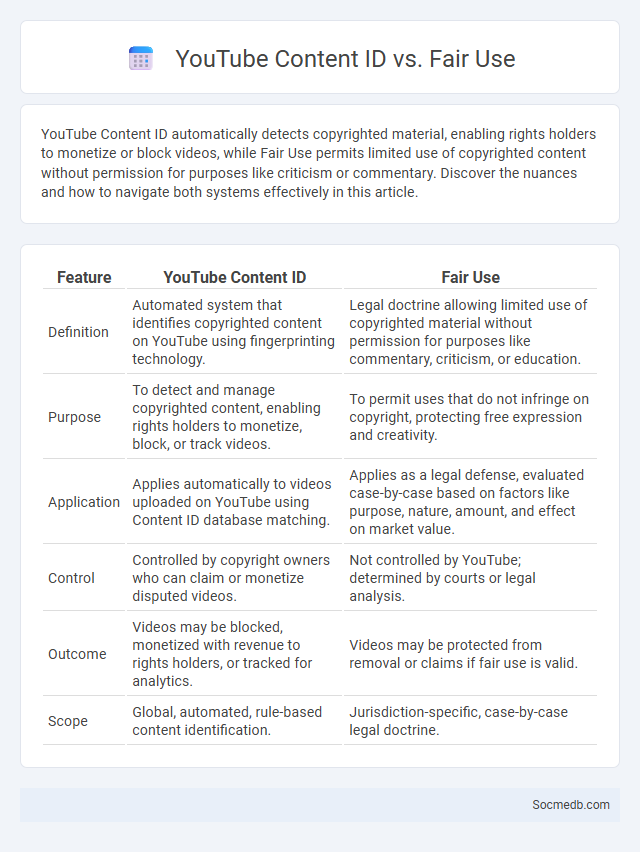
Photo illustration: YouTube Content ID vs Fair Use
YouTube Content ID automatically detects copyrighted material, enabling rights holders to monetize or block videos, while Fair Use permits limited use of copyrighted content without permission for purposes like criticism or commentary. Discover the nuances and how to navigate both systems effectively in this article.
Table of Comparison
| Feature | YouTube Content ID | Fair Use |
|---|---|---|
| Definition | Automated system that identifies copyrighted content on YouTube using fingerprinting technology. | Legal doctrine allowing limited use of copyrighted material without permission for purposes like commentary, criticism, or education. |
| Purpose | To detect and manage copyrighted content, enabling rights holders to monetize, block, or track videos. | To permit uses that do not infringe on copyright, protecting free expression and creativity. |
| Application | Applies automatically to videos uploaded on YouTube using Content ID database matching. | Applies as a legal defense, evaluated case-by-case based on factors like purpose, nature, amount, and effect on market value. |
| Control | Controlled by copyright owners who can claim or monetize disputed videos. | Not controlled by YouTube; determined by courts or legal analysis. |
| Outcome | Videos may be blocked, monetized with revenue to rights holders, or tracked for analytics. | Videos may be protected from removal or claims if fair use is valid. |
| Scope | Global, automated, rule-based content identification. | Jurisdiction-specific, case-by-case legal doctrine. |
Understanding YouTube Content ID
YouTube Content ID is a sophisticated digital fingerprinting system designed to identify and manage copyrighted material across millions of videos daily. It helps content creators and rights holders protect their intellectual property by automatically detecting matches and allowing them to monetize, track, or block unauthorized use. Understanding YouTube Content ID empowers you to navigate copyright claims effectively and optimize your content strategy for compliance and revenue generation.
What is Fair Use on YouTube?
Fair Use on YouTube allows creators to use copyrighted material without permission under specific conditions, such as commentary, criticism, or educational purposes. This legal doctrine evaluates factors like the purpose of use, the nature of the copyrighted work, the amount used, and the effect on the market value. Understanding YouTube's Fair Use policies helps avoid copyright strikes while promoting creative freedom and content sharing.
How Content ID Works
Content ID operates by scanning videos uploaded to platforms like YouTube against a database of copyrighted audio and visual materials. When a match is detected, rights holders can choose to monetize, block, or track the content, ensuring their intellectual property is managed effectively. Your videos are automatically assessed, helping maintain compliance with copyright laws and protecting original creators.
Key Differences: Content ID vs Fair Use
Content ID is an automated system used by platforms like YouTube to detect copyrighted material and manage monetization, blocking, or tracking based on rights holder claims. Fair Use is a legal doctrine allowing limited use of copyrighted content without permission for purposes such as commentary, criticism, or education, evaluated case-by-case. Unlike Content ID, which operates algorithmically, Fair Use requires human judgment and often involves legal interpretation.
Common Misconceptions About Content ID
Content ID on social media is often misunderstood as a tool that only flags blatant copyright infringements, when it also detects subtle uses of copyrighted material such as background music or brief video clips. Many users believe that Content ID automatically results in video removal, but in reality, it can lead to revenue sharing, content blocking in certain regions, or monetization by the rights holder instead. Understanding how Your content interacts with Content ID helps avoid false claims and ensures compliance with platform policies.
Fair Use Criteria Explained
Fair Use criteria in social media revolve around purpose, nature, amount, and market effect of the shared content. Transformative use, such as commentary, criticism, or parody, strengthens fair use claims, especially when using limited portions of copyrighted material. Courts often assess whether the social media post impacts the original work's market value or potential earnings to determine legality under fair use.
Consequences of Content ID Claims
Content ID claims on social media platforms can lead to your videos being demonetized, removed, or restricted, significantly impacting your revenue and audience reach. These claims can also cause account strikes or suspensions if multiple violations accumulate, jeopardizing your channel's growth and credibility. Understanding the consequences of Content ID ensures you protect your content and maintain a reliable presence on social media.
Disputing Content ID Matches on YouTube
You can challenge inaccurate Content ID claims on YouTube to protect your original content and ensure rightful monetization. Carefully gather evidence such as timestamps, original files, or licenses to support your dispute effectively. Following YouTube's dispute process promptly increases the chance of a favorable resolution and maintains your channel's credibility.
Best Practices for Creators: Avoiding Strikes
Creators should consistently adhere to platform guidelines by avoiding copyrighted materials, respecting community standards, and properly crediting sources to prevent strikes. Regularly reviewing policy updates on social media sites like YouTube, Instagram, and TikTok helps maintain compliance and reduce the risk of penalties. Utilizing tools such as copyright-free libraries and content management systems enhances content safety and preserves channel integrity.
Balancing Content ID and Fair Use Rights
Balancing Content ID and fair use rights requires a clear understanding of copyright laws and platform policies to protect creators' work while allowing lawful use of content for commentary, criticism, or education. You must carefully review automated Content ID claims to ensure legitimate fair use is not improperly blocked or monetized, preserving your rights to share transformative material. Platforms like YouTube provide dispute mechanisms, but proactive management and knowledge of legal exceptions are essential for maintaining a fair social media environment.
 socmedb.com
socmedb.com